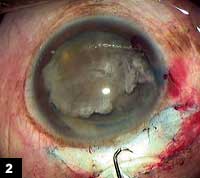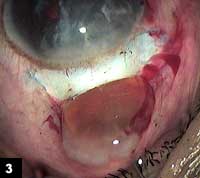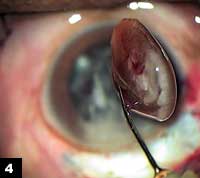Sutureless fishhook cataract technique developed in remote area of Nepal
Surgeon developed the extracapsular technique for use in a high-volume setting when phaco cannot be utilized because of cost.
In Nepal, where 31% of the country’s 23 million people live below the poverty line and preventable blindness is rampant, Albrecht Hennig, MD, has been helping large numbers of cataract patients see again with a high-volume surgical technique he developed called the sutureless fishhook technique.
Of 48,824 cataract operations performed in 2004 at Sagarmatha Choudhary Eye Hospital (SCEH), where Dr. Hennig has been program director since 1983, 44,228 of those procedures were performed using this technique, which involves extracting the whole nucleus through a sclerocorneal tunnel.
At SCEH, located in the town of Lahan just near the Indian border in Nepal’s eastern region, busloads of patients come to have Dr. Hennig and his associates perform cataract surgery. According to the SCEH annual report, many organizations in North India offer “cataract package tours” to Lahan that include screening and surgery for the patient as well as transport and food for the patient and one attendant; 214 buses transported 6,797 cataract patients to Lahan for surgery in 2004 alone.
“Up till now we have performed more than 250,000 cataract extractions with the fishhook technique,” Dr. Hennig told Ocular Surgery News in an interview from Nepal.
Fishhook technique
Dr. Hennig and his colleague Jan Tynovsky, MD, developed the fishhook technique at Lahan Eye Hospital in 1997 as an alternative to phacoemulsification.
“We were looking for a convenient, sutureless technique, which could be easily applied in a high-volume setting and for all types of cataracts,” Dr. Hennig explained.
The technique involves using a small hook made of a 30-gauge needle to extract the entire nucleus out of the capsular bag and through a self-sealing tunnel.
“We first searched for a way to cut the nucleus into two pieces with a bent needle,” he said. “While trying this, we realized that even the whole nucleus can be easily extracted out of the capsular bag and the self-sealing tunnel.”
According to Dr. Hennig, the size of the tunnel depends on the age of the patient and the size of the nucleus. For example, large brown nuclei in older patients might require an 8-mm opening, whereas cataracts in younger patients only require incisions as large as the optic of the IOL to be inserted.
Precise construction of the tunnel, Dr. Hennig said, is a prerequisite for a good visual outcome. An ophthalmologist can construct the tunnel with conventional instruments such as a razor blade fragment, a crescent knife or a keratome, or it can be done with a diamond knife.
|
|
|
|
Images: Hennig A |
|
Three-step tunnel construction
Dr. Hennig uses three steps in the construction of the tunnel: cutting a frown incision, making the sclerocorneal tunnel and opening the anterior chamber (AC).
He begins the procedure with a frown-shaped scleral incision created 2 mm from the limbus at its closest point.
“The ‘frown’ incision has proved to cause the least surgically induced astigmatism,” Dr. Hennig explained.
The next step, creation of the sclerocorneal tunnel, is the most difficult part of the tunnel construction, he said. The tunnel should be made in half scleral thickness and must end at least 1 mm into the clear cornea in order to ensure that the tunnel self-seals.
If the tunnel goes too deep, Dr. Hennig said, it might enter the AC prematurely, which could result in an iris prolapse during surgery that would require suturing. If the tunnel is too shallow, the surgeon risks buttonholing to the outside.
Finally, the opening of the AC can be performed with cutting movements from outside to inside using either a keratome or a diamond knife, he said.
Nucleus extraction
Once the tunnel has been created, the surgeon can then perform a linear capsulotomy with a cystotome, keratome or diamond knife.
Dr. Hennig said he prefers a continuous curvilinear capsulorhexis (CCC) because it guarantees optimal IOL centration. He also recommended staining the anterior capsule with trypan blue in cases of mature white cataracts.
Air is injected into the AC through a side port to assist in staining the anterior capsule. The air is then replaced with viscoelastic, and the CCC is performed with Utrata forceps.
The surgeon must then apply either forceful or gentle hydrodissection, depending on which type of capsulrrhex is created, in order to mobilize the nucleus, he said. In the case of a linear capsulotomy, the nucleus can be slightly lifted at the side of the tunnel using forceful hydrodissection.
In cases of CCC, gentle hydrodissection is performed beneath the remaining anterior capsule, pushing part of the nucleus out of the capsular bag, Dr. Hennig said. The nucleus can then be rotated toward the tunnel where the surgeon must inject viscoelastic in front and behind the nucleus.
The surgeon then inserts the fishhook between the nucleus and the posterior capsule, and turns the tip into the central lower nucleus. Once this is done, the nucleus can be extracted from the capsular bag and through the tunnel, he said.
“Another advantage in comparison to many other techniques is that with the fishhook, the nucleus does not need to be brought into the anterior chamber, but can be extracted directly out of the capsular bag and tunnel,” Dr. Hennig explained.
Dr. Hennig noted that the cortex of the lens acts as a safety cushion and protects the corneal endothelium during extraction. Any remaining cortex can be removed by hydroexpression or with the use of a Simcoe cannula.
On-site training
In addition to training the hospital’s own ophthalmologists in the technique, SCEH hosted four visiting ophthalmologists from India and Malawi in 2004 as trainees in the fishhook technique. Dr. Hennig noted that the program is popular.
“The demand is high, and due to the high numbers of outpatients and operations as well as our long experience with training, our hospital is a very good training center,” he told OSN. “We hardly offer any short-term training, but concentrate on our 2-year anterior segment fellowship to not only ‘invest’ in training but also benefit from the ophthalmologists once they are trained.”
Dr. Hennig and his colleagues have trained ophthalmologists from countries bordering Nepal as well as from Cambodia, Vietnam, Kenya, Zimbabwe and South Africa. These ophthalmologists, he said, are now teaching the technique in their own countries.
“We give preference to Nepali and Indian colleagues, and to ophthalmologists working in developing countries and in projects supported by the Christian Blind Mission,” he said.
Dr. Hennig said that when ophthalmologists are being trained in the technique, it is important that they feel confident and have consistently good results with conventional extracapsular cataract extraction and posterior chamber IOL surgery before converting to sutureless cataract surgery.
He recommended that ophthalmologists getting their start in the technique practice hydrodissection, nucleus mobilization and hook extraction during conventional surgery.
He also said that novice surgeons should begin with immature cataracts so they can see the tip of the hook while inserting it into the nucleus. They should also start with a larger tunnel and smaller nuclei.
“Once the fishhook technique or any other sutureless nonphaco cataract surgical technique is mastered, the immediate good outcome will motivate many cataract patients to go for surgery and therefore will play an important role in the reduction of worldwide cataract blindness,” Dr. Hennig said.
For Your Information:
- Albrecht Hennig, MD, can be reached at Sagarmatha Choudhary Eye Hospital, Lahan, by mail c/o UMN, P.O. Box 126, Kathmandu, Nepal; 977-1-5538761; fax: 977-1-5538096; e-mail: ahennig@mos.com.np.
- Sagarmatha Choudhary Eye Hospital can be reached at 977-33-560402, 560491; fax: 977-33-560492; e-mail: info@lahaneye.org.np.
- Jared Schultz is an OSN Staff Writer who covers all aspects of ophthalmology. He focuses geographically on Europe and the Asia-Pacific region.




